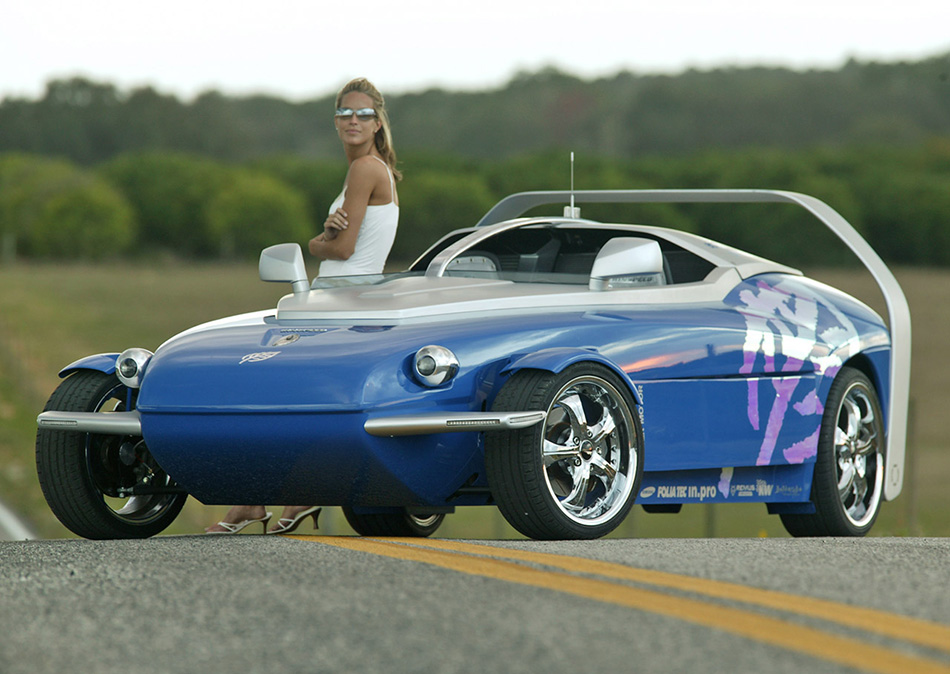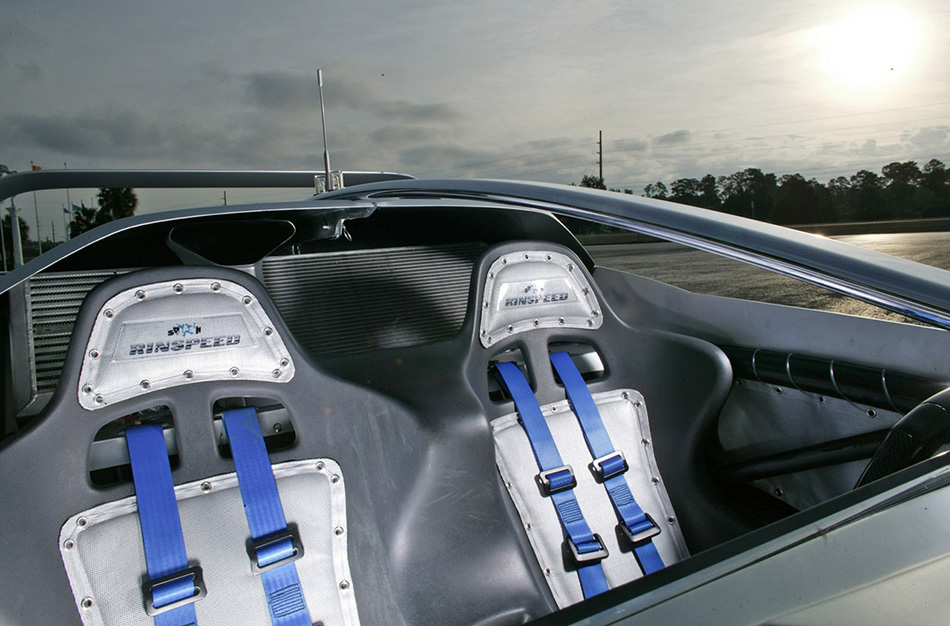In what has become a fond tradition Rinspeed Design, the Swiss creative powerhouse for automotive concepts and emotions, presents yet another surprising and astounding attraction at this year's Geneva Motor Show. To celebrate their 10th concept vehicle the Rinspeed crew has created the Rinspeed "Splash".
Under the ultra-light carbon-composite skin lies much more than just an agile and lively sports car. The Rinspeed "Splash" is the true incarnation of a really cool and fun sports toy. At the push of a button a cleverly thought-out hydraulic mechanism transforms the sports car into an amphibious vehicle. But that alone wasn't enough for Frank M. Rinderknecht (48), founder and boss of Rinspeed. A highly complex integrated hydrofoil system enables the "Splash" to ‘fly' at an altitude of about 60 cm above the water.

On land, on water, and in the air
The almost magical transformation from a street vehicle into a floating and ‘flying' all-rounder is made possible by an electronically controlled hydraulic system with an array of sophisticated sensors.
The transformation starts with the nondescript rear panel, which flips up to reveal a Z-drive in horizontal rest position, borrowed from a watercraft. The Z-drive is fitted with a conventional 3-bladed propeller and can be lowered to its fully ‘standing' position from the cockpit. The position of the drive is infinitely variable, which guarantees immediate propulsion upon entering the water. A custom-designed transfer case sends power to the rear wheels, the propeller or both, depending on the input from the pilot. Starting at a water depth of about 1.1 meters the Z-drive can be lowered all the way to its fully ‘standing' position. Steering commands are entered via the steering wheel and transferred to the Z-drive.
At a minimum water depth of about 1.3 meters the pilot can deploy a highly complex system of hydrofoils integrated into the sleek body of the "Splash." The Formula-1 type rear spoiler rotates 180 degrees down and comes to rest below the "Splash." To the left and right of the high side walls of the cockpit two hydrofoils integrated into the outside skin rotate 90 degrees to point straight down before unfolding into their lifting V shape.
The angle of attack of each hydrofoil can be adjusted individually by the pilot to account for the various operating states. Already at low speeds the vehicle begins to lift itself out of the water. The fully suspended position can be reached at speeds as low as 30 km/h. The unusual vehicle then travels as a true hydrofoil at an altitude of about 60 cm above the water. Even the wheels are free of water contact. On smooth water the "Splash" is capable of reaching a top speed of about 80 km/h (approx. 45 knots).
Naturally the "Splash" can also be operated as a ‘conventional' amphibious vehicle. With retracted hydrofoils the "Splash" reaches a top speed of almost 50 km/h (approx. 28 knots). That is fast enough for water skiing or knee boarding.
The body of the "Splash" is designed to be watertight. Additional buoyancy chambers provide extra lift. Also borrowed from shipbuilding are a bulkhead design with independent chambers and bilge pumps – in case some water does find its way into the cockpit or the engine bay. Fourteen rubber bellows guarantee freedom of movement of drive train, suspension and steering.
Compact natural-gas power from just 750 cm3
The "Splash" is powered by an environmentally friendly bivalent turbocharged natural-gas engine. Natural gas is an extremely clean-burning fuel that consists almost entirely of methane with near-zero sulfur content. The "Splash" is the world's first amphibious vehicle to be equipped with this future-oriented engine technology.
Preserving the environment does not mean sacrificing driving fun - and neither does the low overall weight: The turbocharged two-cylinder four-valve engine from Weber Motor powers the watercrafts and snow mobiles from Polaris, albeit as a gasoline-powered engine. In its bivalent turbocharged natural-gas configuration the engine delivers a maximum power output of 140 hp/103 kW at 7'000 rpm. The peak torque of 150 Nm is available at a low 3'500 rpm. Street performance is nothing to be ashamed of: The 825 kg quick-change artist accelerates in about 5.9 seconds to 100 km/h and reaches a top speed of 200 km/h.
No bounds
The sleek lines of the "Splash" draw attention at first glance. However, one of the basic ideas behind the "Splash" concept was to design an automobile whose multi-functional capabilities are not immediately apparent. Hardly anyone will realize that the ‘soft-edge design' "Splash" can fulfill the age-old child's dream of almost boundless mobility at the push of a button.
The entire body of the "Splash" consists of multi-layered carbon composite, a state-of-the-art plastic mainly used in Formula One racing. It offers exceptional stability at a low specific weight. The striking bodylines of the "Splash" are the expression of the fine art of engineering. The low windshield protects against drafts and its tinted Folia Tec glass contributes to the futuristic chrome look.
The sporty stainless-steel exhaust system from Remus provides the adequate powerful engine sound. The chrome-plated dual exhaust tips give the "Splash" a unique and highly dynamic rear appearance.
The lightweight body sits on a suspension custom-developed by KW automotive. It features inboard shock absorbers, adjustable ride firmness and height. The suspension engineers succeeded in creating a suspension that represents a perfect synthesis of ride comfort and sporty handling characteristics.
In.pro. custom-developed chrome-plated bi-xenon headlamps for the "Splash" as well as LED taillights. The latter not only represent the beginning of a new design trend, their ability to come on almost instantly also contributes to the prevention of accidents.
Aye aye, Captain
The interior of the "Splash" clearly pays tribute to its maritime qualities. Lightweight and waterproof plastics cover the tubular frame and the ergonomically shaped plastic seats. The small sport steering wheel is perfect for the agile handling characteristics of the lively and highly maneuverable "Splash." A number of chrome-plated shift knobs, which govern the amphibious functions and the angle of attack of the hydrofoils, exude an atmosphere reminiscent of an airplane cockpit.

Hydroplaning - on water only
The Rinspeed "Splash" runs on Continental SportContact tires with 17-inch diameter in front (215/35-17) and 18 inches in the back (225/35-18). The Continental tires combine environmentally friendly design, very good handling characteristics and excellent grip. They are mounted on chrome-plated aluminum rims (7x17" front, 7.5x18" rear) custom-made by Barracuda.
SWISS MADE
Esoro
Frank M. Rinderknecht used highly advanced technology and a Swiss-based network of top automotive specialists for his project. Although there is no automobile production in Switzerland to speak of, there is a very active automotive supply industry there. Many highly innovative prototypes have been developed and manufactured in Switzerland.
Engineered by Esoro - What you dream is what you get
For the fifth time the Swiss engineering company Esoro was hired to serve as general contractor for the entire vehicle project. Esoro was responsible for project management, engineering, design and manufacturing of the Rinspeed Splash.
Esoro masterfully met the challenge with the help of its highly competent suppliers Naval (marine), Swissauto (drive train adaptation) and Protoscar (styling). Starting with initial concepts, it took the highly skilled development team just seven months to realize the entire project including tests on the road, on the water and in the "third dimension" by flying at high speed over a lake.
Esoro has been a contract developer in the areas of automotive production, lightweight design and plastics technology for 13 years. During this time it has gained a well-deserved reputation for excellent efficiency and innovative solutions not just in these but also in other fields, including fuel-cell vehicles and prototype design. Esoro has impressively demonstrated its expertise with numerous extraordinary prototypes.
And even more: Esoro developed the new E-LFT production technology, which makes large scale production of high-strength and lightweight composite parts affordable. E-LFT composite parts weigh 30-50 percent less than comparable steel parts. Furthermore another production process for similar parts, but small scale niche markets is near completion.
Gasmobil - A Strong Partner
The spread of natural gas as a fuel of choice is supported by the shareholders of gasmobil AG and local natural gas suppliers. Natural gas is a meaningful and environmentally friendly alternative fuel, which can make a significant contribution to the reduction of harmful pollutants, especially in congested urban areas. When combined with CO2-neutral biogas, the pollution emission levels are improved significantly. The most important arguments for natural gas and biogas as fuels: Lower pollution levels compared to gasoline or diesel; better mileage in hybrid versions and therefore also more economical, lighter and cleaner refueling; subsidies for the purchase of any new vehicle in some cantons; manufacturers' guarantees; and vehicle safety similar to all other passenger cars.
Natural gas and biogas as the fuel of choice - the future is now
gasmobil, SwissEnergy and Rinspeed - three strong partners, who develop vehicles for everyday operation and future visions for mobility. The vehicles jointly displayed are fueled by environmentally friendly natural gas or biogas: the VW New Beetle Cabriolet uses standard drive train technology. The VW Golf Variant has a novel exhaust treatment concept, which was developed for gasmobil AG together with ETH Zurich, the Swiss Federal Department of Energy (BFE and SwissEnergy), the Paul Scherrer Institut Villigen (PSI), Automobil- und Motoren AG (AMAG), the den Industriellen Werken Basel (IWB), as well as the Gasverbund Mittelland AG as part of a Novatlantis Project entitled "An Innovative Vehicle Fleet For Basel". The splash demonstrates that even unusual drive train concepts can be used both on the road and in the water every day.
Fuel supply - no problem in Europe
Employing natural gas and biogas means taking another step on the way to less crude oil dependence for the world's economy. The tremendous environmental potential of natural gas cannot only be exploited in static use, but also by road vehicles to reduce harmful pollution levels from soot, nitrogen oxide, CO2, and hydrocarbons. Furthermore, natural gas motors reduce noise pollution levels compared to conventional units. These drive technologies are mature and market-tested. It is hard to find a manufacturer which does not have one or more models in its program. In addition to this, the gas station network in Switzerland and the rest of Europe is being developed rapidly. Round-the-clock supply is guaranteed.
SwissEnergy's Ongoing Commitment
Through its SwissEnergy program, the Federal Office for Energy has been promoting the use of natural gas and biogas for over 10 years. Initially it mainly supported research work. Between 1996 and 2000 SwissEnergy supported a pilot and demonstration project with "Kompogas" vehicles in the region around Zurich. Over 100 vehicles were put on the road as part of the project and the responses by users were very positive.
Meanwhile, the Swiss gas industry has been establishing a network of natural gas refueling stations and the car industry has been expanding its range of natural gas and biogas vehicles. For three years now, Gasverbund Mittelland AG, Rinspeed AG and SwissEnergy have been working closely to promote natural gas and biogas as a motor fuel. The concept cars designed by Rinspeed AG enable the public to visualize the possibilities offered by natural gas as a motor fuel and serve to dispel the prejudices against this young and clean form of fuel that unfortunately continue to prevail. The use of natural gas and biogas as motor fuels helps to spare valuable resources and generates lower emissions than traditional motor fuels. Natural gas produces around 20% lower emissions per energy equivalent of the greenhouse gas CO2, and renewable biogas fuel is even CO2-neutral.
Source: Rinspeed





















